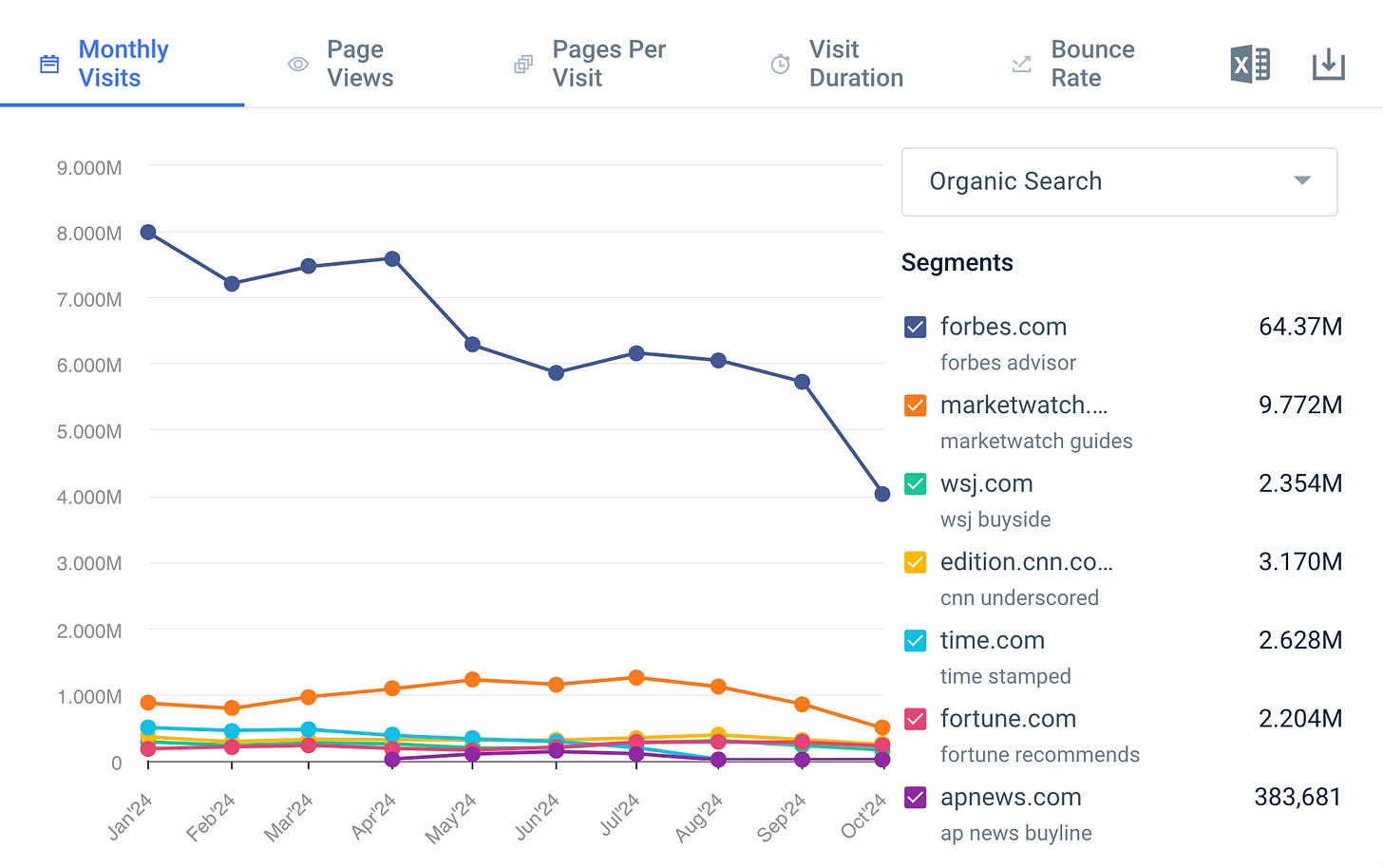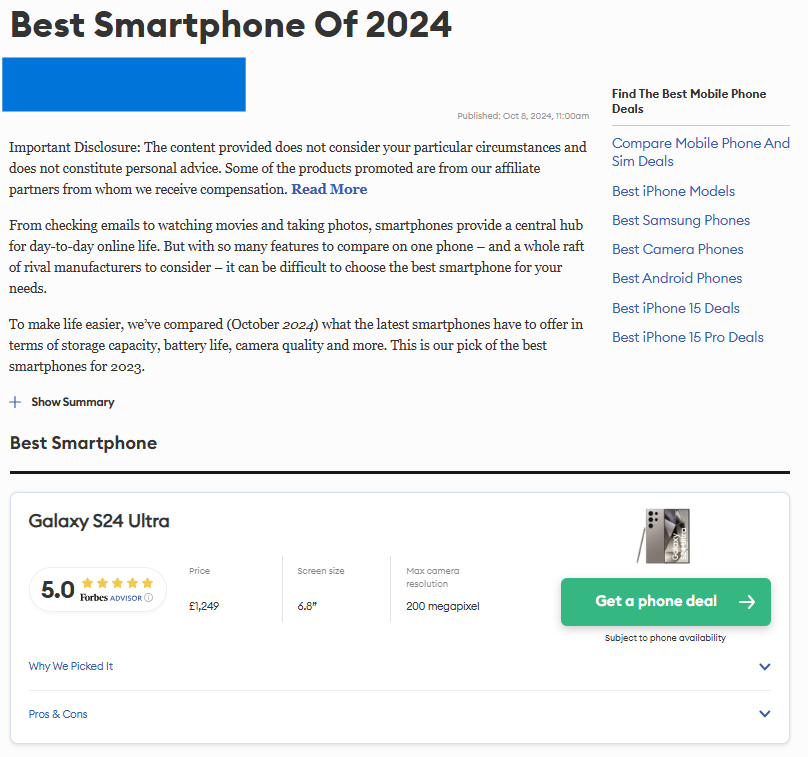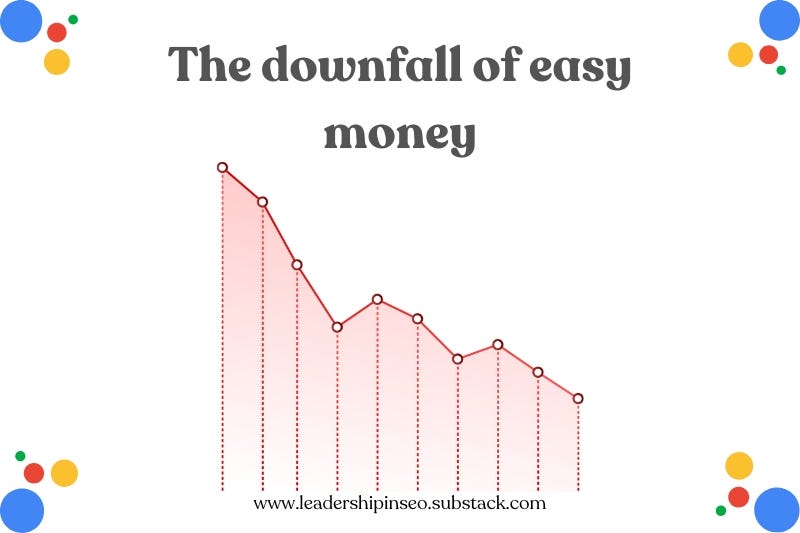The downfall of easy money
What the downfall of big publishers' affiliate and partnership content tells us about the state of search
First, some context.
The affiliate sections of big publishers have been decimated over the last six months. Forbes Advisor (50% drop) was the big fish to fry. But closely followed by;
AP News Buyline - 98% drop
Time Stamped - 97% drop
Marketwatch Guides - 56% drop
CNN Underscored - 25% drop
WSJ Buyside - 55% drop
Fortune Recommends - 20% drop

In fact, since I started writing this article, CNN Underscored and possibly Forbes Advisor may shut down. Or at least drastically reduce operations. These are crazy times indeed.

All big US publishers lost at least 50% of their traffic, some 99%. Initially, we thought this was a further rollout of the parasite SEO and site reputation abuse update. The bloated leech had returned to finish the job.
On further investigation—mainly from excellent SEOs like Marie Haynes and Lars Lofgren—that doesn’t appear to be true. This looked more algorithmic. Or looks should I say. The manual action was complete obliteration. Vanished off the face of the earth like a recently disgraced television presenter.
For most of these publishers, it’s been a 50-65% traffic loss. Disastrous, yes, but not flushed into the apocalyptic plumbing system below Google HQ. A few fingers remain clinging onto the proverbial rim.
Things always start with the US market. So whilst these are all US publishers the UK market is sure to follow. Now, before we and every other publisher hit the panic button (and after the year everyone’s had I’m sure we’d be forgiven), I decided to do a little digging.
But first, we should clarify a few things.
To start, I should clarify that I have some skin in the game. I’m the SEO Director of a big publisher (The Telegraph). Like many publishers this year, we received manual action.
How do we classify quality, helpful content?
We need to dig much deeper than just a cursory glance over the content. Most of the publishers in question have huge budgets and teams to call on.
The only way to fairly and adequately analyse the affiliate sections of these publishers is to use Google’s Quality Rater Guidelines. This 180-page behemoth of a PDF with typically appalling Google branding is the best way to review content in the wake of an algorithm drop. It lets us see how a bot determines whether content appears spammy and adds value.
It covers;
Page quality
Needs met
UX
Monetisation
As the bedrock of evaluating quality pages, this should form a core part of your SEO knowledge. It can help you establish true E-E-A-T and whether the user’s needs are being met. There is some crossover between these sections, but you get the idea.
A broad overview of this affiliate content
With the eye test, all of this content looks very reputable. It’s clean. Fast. Very few broken links. Well-optimised headers. Succinct. There are authors present on all the pages. Bylines. Reasonably well-optimised structured data.
A few years ago this content would’ve ticked most of, if not all the SEO boxes.
But to me, that’s become the problem. If we truly focus on what makes a good quality page, then these sites have dropped the ball massively. They’ve grown too quickly. Every single one of them has created a poor quality product because they could. If the ranking system rewards your well optimised content, you can fall into the trap of thinking it’s good.
Success can be too easy.
The problem is that algorithms learn and evolve. As Google’s index continues to grow, they’re becoming pickier when it comes to what to rank. And none of this content adds value. Whilst there are some About Us pages that espouse the ‘integrated partnership,’ the reality is that these brands are so strong they can rank for virtually anything. On balance, I’d say the bigger the brand, the worse the content is. They just don’t have to try as hard to rank.
It’s why the Parasite SEO update was smart and essential. Particularly given Google didn’t attack it algorithmically. They’d learnt something since the HCU at least. You have brands that can rank for anything and enough budget to tick all the boxes when it comes to design and technical improvements. But a complete lack of anything resembling true quality.
No first-hand experience. At all. No quality imagery. I reviewed dozens of affiliate articles from the above hubs and I didn’t find one image, video or unique visual that told me these people have truly used these products. Just mission statements, bland methodologies and snazzy product tables.
Good content requires effort. But it’s quicker to use stock imagery. It’s easier to use the same suppliers and it’s easier to outsource everything with minimal oversight. And if you’re already ranking in position 1 for everything, why invest more?
Well, now you know.
Main content vs supplementary content
This is a key part of the Quality Rater Guidelines and in my mind helps frame a few key concepts. We can rigorously review whether the quality of the main content of the page is enough to satisfy the user and helps the page achieve its purpose.
Yes, this is about factual accuracy and a page that answers questions a user asks concisely. But it’s about more than that. It’s about effort and originality, being hard to replicate and creating something that no one else is.
Something that is very difficult to do when you all work with the same or at least very similar third parties.
The supplementary content should do two things.
Help users and search engines contextualise how closely this content is related to the crux of your site
Plays a key role in the page’s UX
As Google alludes to in its Quality Rater Guidelines, big brands are treated very differently to hobbyists and niche sites. You are judged to a higher standard when it comes to the overall page experience because you have more to offer. Design resource, experience, industry knowledge, contacts and, crucially, time.
Or at least they should be.

Needs met
The needs met framework covers the page intent, how well the content answers the question(s) and the accuracy and relevancy of the content. It’s very closely linked to the quality of the page but helps us categorise pages based on how effectively they meet these criteria.

Broadly these sites do answer the question. What’s the best credit card? What’s the best dental insurance in Hawaii? (You may think I’m being facetious, but this is a very genuine article on at least one of these sites.) They are, if nothing else, concise.
But does that equate to being a ‘very helpful’ page? If the page is cluttered with paid placements above the core questions and ambiguous statements about market research and testing, does that meet the needs of a discerning consumer? In the financial sector? Read Google’s advice on creating helpful content if you’re unsure.

E-E-A-T and page trustworthiness
The most popular acronym since IKEA (bet you didn’t know that was an acronym either), E-E-A-T may finally be here to stay. And in a big way. Pages have been judged by quality raters based on how trustworthy the page is for some time.
Does the page show true first-hand experience? Something particularly important for affiliate content
Is the author and/or website a respected expert in their field? Is it clear and obvious?
Do they have the authority to speak on the topic in a way that commands you to listen?
Whilst industry-specific links are still king, this update has potentially laid to rest the ability for strong brands to rank based on who they are. Or perhaps what they were.
With affiliate topics - particularly those in the YMYL space - these pages have to show applicable and obvious first-hand experience. Equally, they must highlight their awards and credentials on the topic, engage with their audience in a meaningful manner and cite reputable sources among dozens of other things.
After the Parasite SEO update one thing I am sure of is that what you say on your site means something. Scrutiny is applied. Quality Raters read and reviewed minute details, as Danny Sullivan insinuated in a publisher meeting.
Reputation
Researching the reputation of the website and the content creator seems like a no brainer doesn’t it? It’s what the Quality Raters do.
How reputable is your brand?
Who has the content creator written for?
Where have they been mentioned?
Where have both the brand and the author been cited?
The interesting thing about reputation is that the reputation - of both the brand and the author - for most of these sites is good. At least on the surface.
Big brands. Huge search volume. A backlink profile that makes you a little weak at the knees. Authors who have written for all the big names. Maybe even featured in some very specific industry publications.
But they haven’t gone above and beyond. And maybe that’s the difference here. If you work for a huge site, then the expectations on you are now magnified to weed out the true experts. Are you building a social presence as an author? Have you created video content showcasing your expertise? Appeared on podcasts?
If you aren’t, others will be. And maybe they’ll be rightly lauded.
Or maybe Reddit, Quora and Google’s new recipe feature where they quite literally take the recipe from your page and plop it on theirs (in full mind you) will slop up the spare share of voice like pigs in shit.
A deeper dive
I’m not going to go into every brand individually. Particularly when some of them use the same third parties to create the same content (cough, Taboola, cough). They all make the same mistakes and have the same lack of true E-E-A-T. Something that may finally be rolling out.
But let’s dive into a few in more detail.
Forbes Advisor
With a 50% organic traffic loss since the peak this year, Forbes’ Advisor’s ability to rank in position 1 for everything is well and truly over. Let’s take their best credit cards page as an example.

I almost can’t think of a page more entrenched in the YMYL space. Banking. Credit cards. Debt. A powerful brand, viewable on-page authorship and a ‘why you can trust us’ section doesn’t constitute high-quality E-E-A-T in this scenario.
This isn’t something that can be treated the same as a vacuum cleaner.
Above the fold we have;
Clear authors, both editors of the brand
Reviewed by an Insight Analysis, who is a Defaqto bank consultant ‘with more than 20 years in the industry’
An ambiguous ‘market-wide survey’
And a paid placement above the fold
I could go on. The rest of the page is completely devoid of any true first-hand experience, effort, originality and all the things now demanded. SEO-wise, the page ticks the boxes. But that’s part of the problem. This isn’t a box ticking exercise.

And, to be fair, the ambiguous methodology doesn’t appear on other pages of Forbes Advisor. So maybe it does exist. But what I find remarkable is that someone decided to add a paid placement to the best credit cards page, but not here. Revenue and profit over quality.

In the cold light of day it looks like remarkably poor oversight to put paid placements at the top of such a page. But hindsight is a wonderful thing.
Time Stamped
I almost feel like I don’t need to go through any further content because it’s all so similar. But unless I show you at least one more example, I probably won’t have built a strong enough narrative to convince you otherwise.
Apart from lacking and obvious byline and clear expertise about who the author is (which is a big oversight), the disclaimer and author are clear and linked. Whether the disclaimer is a pro or a con in this scenario is another conversation.
Interestingly, when I search for any mention of this author outside of time.com, Forbes Advisor is the top result. Another publisher known to create thin financial content at scale. With what we know now, this probably isn’t a ringing endorsement.
And the rest of the page is as you’d expect. It looks good. Is clearly laid out with well-optimised headers, (presumably) accurate information and has all the nuts and bolts information that you as a user would want to know when it comes to credit cards.
Once again, it all boils down to effort, originality and uniqueness. And the lack of it on this highly intrinsically YMYL topics is damning.
Summing up
There comes a point when every brand has to really ask themselves whether their product is any good. It goes beyond SEO, traffic and revenue.
We need to become SEOs who understand the wider ecosystem and how search continues to evolve. SEOs who can influence wider business decisions and question whether following the suggested approach is the right way forward. The way forward that delivers quality content. Not just content that meets basic search criteria.
If that’s you, I suggest you use this as a warning. You need to become a decision maker.













